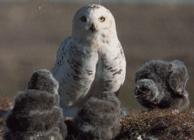

Common Names: Cat
Owl
Genus: Nyctea
Species: scandiaca

The snowy owl is considered to be one of the largest and most attractive of the owls. It is called the snowy owl because of its white feathers. The male and female owls have different markings. Male owls are mostly pure white with small spots and wing barring. The female has heavy gray-brown lines across her body and wings and speckled plumage. They both have large, yellow eyes, set in front of the face. Their ears are large and hidden under dense, white feathers. The snowy owl weighs 4 to 6 pounds and is 21 inches to 26 inches in length. The wings can span 4.7' to 5.4' in width.
They reach sexual maturity at 3-5 years old. The snowy owls choose one mate every breeding season, because they migrate. Their nest is a hollow, formed out of frozen turf and moss on a ridge or hill.
The male owl uses his echoing calls to find a mate. They look for a mate late in winter. He brings his mate an offering of food and displays his feathers to get her attention. After mating they search for a place to nest. The female owls can lay 2-16 eggs, but usually lays 5-7. The eggs are round and white. Incubation period is 30-33 days. The female owl lays the eggs two to three days apart from each other. By the time the last egg is hatched, the oldest nestling could be 2 to 3 days older than the youngest. When food is scarce, the larger birds eat the weaker, smaller nestlings to survive. Both male and female owls provide food for their young. The owls' plumage helps to camouflage the female owl as she sits on her eggs.
The owl can see its prey with both eyes at once, like humans. Their eyes take up more space in the skull than the brain. The snowy owls hearing is very sensitive and they can pinpoint voles and lemmings under deep snow. Their wings are long and broad, which allow it them fly close to the ground to catch its prey. Claws are long, curved and needle like. They act like weapons for catching and killing its prey.
These owls are silent, unless claiming their territory or protecting their nest. When they do this, they have a loud, deep, hollow hoot, which can be heard up to 2 miles away. When protecting the nest they use a loud barking and quacking sound. The female owls have a loud wail.
They are usually shy and hard to get close to. They will fly away at sudden sounds or movement, which can be heard a mile away. They inhabit low areas of open ground, where dry, rocky hillocks stand exposed from the snow. When traveling across the open sea, they will sometimes rest on icebergs or ice floes.
The snowy owls feed on arctic fox, rabbits, lemmings, voles, and various seabirds. When breeding, it will take food back to the nest to feed the chicks. The owl's stomach can digest the meat of its prey, but not the bones, skin, hair and teeth. The bones form a pellet (a tightly packed lump of these remains) which the owl later coughs out. These can sometimes be found on the ground where owls roost. By examining the contents, you can tell what it has been eating. Owls usually hunt at night, but because the snowy owl lives in the Arctic where there is no darkness in winter, they must hunt for their food during the day. They attack silently, using four powerful talons to reach out and grab its prey. To kill it, they bite its neck at the base of the skull. Smaller prey are swallowed whole. The snowy owl is a predator and helps to keep the environment from overpopulating.
At one time the snowy owl was hunted and trapped by man, but they are now protected. There is a threat of man inhabiting the remote areas where these birds live. This can become a problem, because it will limit the owls space to live and deplete its prey.
by Travis T. 2001
Bibliography:
Burnie, David, Birds and How They Live, New York: Dorling Dindersley, Inc. 1992.
Burnie, David, How Nature Works, London: Dorling Kindersley Limited, 1991.
Patent, Dorothy H., Feathers, New York: Cobblehill Books, 1992.
Taylor, Kim, Owl, London: Dorling Kindersley Limited, 1992.
Zim, Herbert S., Owls, New York: William Morrow and Company, 1977.
"Snowy Owl", Wildlife Explorer, International Masters Publishers AB,USA.